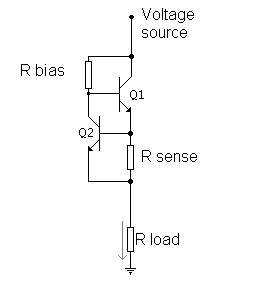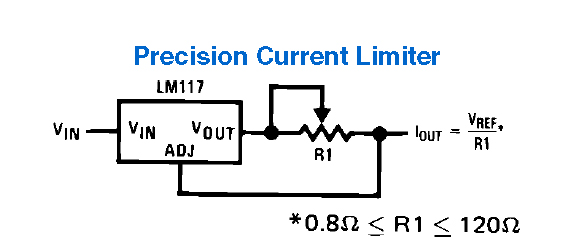current limiting circuit - opinions
I can search and find hundreds of current limiting circuits, however if you have a favorite or have any pointers I'd like to hear them. The main two circuits built from discrete components I know of are the transistor and LM317 current limiters. They vary from two to forty components.
I'm running my Prop off a 50mA current limited bench top supply through a 3.3V regulator. I'm using a four cell NiMh pack to power six RC servos controlled by the Prop. Now I'd like to use the NiMh pack as supply for both the Prop AND the servos, but I'm still going to be developing the system so I'd like to keep the current limiting function for the Prop..... hence my interest in a circuit.
I'm not knowledgeable enough to look at a particular circuit and decide if it's good or bad. The LM317 looks pretty appealing to me though a short circuit might destroy the device (not the Prop).
Transistor:
http://www.vidisonic.com/2008/07/10/current-limiting-circuit/

LM317 pg20 of data sheet
http://www.ti.com/lit/ds/symlink/lm117.pdf

I'm running my Prop off a 50mA current limited bench top supply through a 3.3V regulator. I'm using a four cell NiMh pack to power six RC servos controlled by the Prop. Now I'd like to use the NiMh pack as supply for both the Prop AND the servos, but I'm still going to be developing the system so I'd like to keep the current limiting function for the Prop..... hence my interest in a circuit.
I'm not knowledgeable enough to look at a particular circuit and decide if it's good or bad. The LM317 looks pretty appealing to me though a short circuit might destroy the device (not the Prop).
Transistor:
http://www.vidisonic.com/2008/07/10/current-limiting-circuit/

LM317 pg20 of data sheet
http://www.ti.com/lit/ds/symlink/lm117.pdf



Comments
-Phil
??? I've never heard of such a thing! I'm reading about that now
Edit:
Wow, according to that particular link 15mA is considered high current. I can't find anything for 50mA from that mfg but I'm looking for current limiting diodes in general now. I also need to find out what happens in a short circuit with this device.
Edit again:
Alright, while that device is very cool and should be kept in mind..... I wonder if it's a new device?...... the maximum current limit is about 15mA. There is a method to expand the current capacity with support circuitry which looks very similar to the transistor circuit above plus the CLD, but then I don't know if I've gained anything.
http://www.centralsemi.com/PDFs/products/Boosting_the_CLD.pdf
I DID see where you can use multiple CDL's in parallel to multiply the capacity, so for 50mA I'd use four CDL's in parallel.
Thank you though. I'm gonna keep looking.
-Phil
4.8V nominal pack voltage, The prop requires 3.3V. As Phil said it requires a minimum 7V supply (3.3V +3.75V). I could run a five cell pack for 6V, however that still doesn't sound like enough.
Phooey.
I'm still researching this.... I'm just not finding the answer I hoped to find. There might be a good reason though eh?
Some of the tektronics scopes actually used these in their circuits.
FF
Which regulator? There are a lot to choose from, but a classic solid design (Bob Pease's group at National) is the LP2950. You can get that in a TO92 package, 3.3V with 150mA current limit. The current limit not exact, but that is not important if all you need to do it protect the Prop from short circuits and acrid smoke. The current limit is well controlled, and the chip designers had in mind that you might use it as a current limiter, as shown by the attached diagram from the LP2950 data sheet. That could also work with the 3.3V version or the adjustable version. A similar option is the LT1121-3.3 from Linear Tech, also available in TO92. I would stay away from some of the pMOSFET regulators such as the MCP1700 series from Microchip. They are perfectly good regulators, but they are less bulletproof and can be seriously damaged by short circuits or load dumps. There are a lot more options these days if you want surface mount.
Sorry about my error. I multiplied 4 x 1.5V instead of the 1.2V of a NiMH battery. As far as I know there is no chip out there that will give you both voltage regulation and current limiting with only 1.5V of head room. You might be able to build something using discrete components or a pass transistor and single supply op amps but you would be hard pressed to come up with anything better than a standard LDO regulator.
I can understand protecting the prop from overvoltage condifions, but what point trying to current limit the supply into the prop? It will only draw what it will draw with 3.3V and even though the output pins are rated at a max of 40mA, what are the chances you will be using more than 10 of these solid at one time? Possibly I am speaking out of turn, but it seems that if one has a specific load attached, the only way to reduce/limit the current into that impedance will be to reduce the voltage. Which will then cause the device not to function reliably if at all should you go below the minimum rated voltage for the device. It does seem odd that the max current listed on the data sheet is less than the sum of 10 I/O pins imax. Maybe I will hook up a dip prop and take all outputs low or high and through the resistance to give 33 mA each and see what happens as each one is turned on....... Teach me on this one if I am missing something.....
FF
During development I too like to power things with a current limited supply. The prop itself with loads is hardly ever more than 100 mA. I set the current limit to just above the maximum that the circuit is going to draw. Then if something short circuits, drop a box of pins on the circuit board,input to the power supply, Vss to Vdd instead ???, the bacon is usually saved from frying. There are simply too many wires lying across my workbench. I would guess that spiral_72 is going to have to power the servos via a different path, so there is still danger that the paths might cross in bad ways.
I haven't found a circuit personally. Some of the transistor circuits are better than the standard LM317, but given the low voltage I start with, it just won't work. I'm going to look at those devices Tracy mentioned in post #8. That looks very promising! It's either that, four parallel CLD's or a handful of fuses..... all I have right now.
Thank you so much for the advice so far. I'll check back and let you know how it's going. I'd like to order some components from Jameco anyways.
I would post a schematic but I have been unable to upload anything for a while so PM me with your email address if you are interested and I will email a schematic to you.
Jameco doesn't have the (my) preferred LT1121-3.3 in a through hole package and that's where my shopping cart is at.
They do have the LP2950ACZ-3.3/NOPB though which looks pretty impressive. According to the datasheet: https://www.jameco.com/Jameco/Products/ProdDS/1323397.pdf
it has a 380mV typical low dropout voltage at 100mA, 100mA rated current and in a tiny TO-92 package for $0.89
I don't understand how the overcurrent is handled, but I assume it's not thermal since the output in current shutdown is only a couple uA.... but someone more knowledgeable might know better.
Uh, thank you for mentioning that. I don't understand, it's rated for 100mA, but current limited to 200mA!!?? ARG! I was just about to purchase it too. I'll see if I can find another one.
Edit: I don't see anything else. Maybe I can use the LP2950ACZ-3.3 and a current limiting resistor for 50-100mA. That's better than dumping 1.4A through a resistor with the typical TO-220 device I guess.
I'm also buying some low voltage dropout TO-220 3.3V @ 1.5A Vregs just in case. I think it was 0.6V LVDO
Now I'm not quite sure what you are getting at.
The LP2950 is rated to supply up to 100 mA in normal operation, but that is not a hard limit. The hard limit comes at close to 160 mA, and any attempt to give it a heavier load or a short circuit will cause the current to stay constant at 160mA and for the output voltage to drop accordingly. The current limit by design operates instantly and separate from the thermal limiting, which can kick in later if the chip gets hot. I just tested 10 of them I had in a drawer and they all limited to short circuit at between 160 and 180 mA, fairly well controlled.
Is there some special reason you want to set a current limit of exactly 50mA?
The data sheets from National are great; full of application circuits and even an internal schematic to help one appreciate its internal complexity. Here is another current limiter that uses the 8-pin LP2951. The chip is being used without external feedback, so the output voltage equals the input voltage, unless the current exceeds the limit point of ~160mA.
Maybe instead, you want a latch that simply turns off the power quickly when a fault occurs. Here is the next NSC circuit, which performs that function. The error flag goes low when the limit is exceeded, and that reaches around and pulls the SD (shutdown) high and that latches the load and quiescent current down to microamps. You have to press reset to get it going again.
By the way, CLDs, Current Limiting Diodes do take several volts across them in order to develop their constant current. At least a couple volts of overhead is true of all 2-terminal current limiters. The only way to get both constant current and low dropout is with a three terminal device (such as a low dropout regulator).
@Kwinn. The wall mount protoboard sounds almost too good to be true! I can't imagine being so well organized! I've never actually dropped a box of pins on a circuit, but alas, something like it, and I've hooked up power backwards to circuits more than once.
I know me, and I have to work on the kitchen countertop. the stuff has to be packed into a small pile at the end of every night. I've hooked up power backward, made wiring errors and literally melted a protoboard with a 4-cell pack, dropped screws across IC pins.... you name it. I'd be very upset if I smoked my BS2px or my Prop. I love building micro powered "Stuff" and I'm good at programming IMO, I'm just dealing with my clumsy-ness and cramped space.
I'll report back when I get the stuff
I'm stuck in a programming problem right now, but soon as I clear that up I'll build the test regulator circuit and report back here.